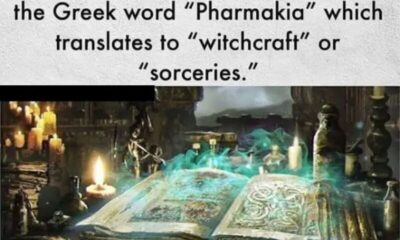Apostasy
Why Did the 1611 KJV Include the Apocrypha?

Why Did the 1611 KJV Include the Apocrypha?
QUESTION: Didn’t the King James Bible when first printed contain the Apocrypha?
ANSWER: Yes.
EXPLANATION: Many critics of the perfect Bible like to point out that the original King James had the Apocrypha in it as though that fact compromises its integrity. But several things must be examined to get the factual picture.
First, in the days in which our Bible was translated, the Apocrypha was accepted reading based on its historical value, though not accepted as Scripture by anyone outside of the Catholic church. The King James translators therefore placed it between the Old and New Testaments for its historical benefit to its readers. They did not integrate it into the Old Testament text as do the corrupt Alexandrian manuscripts.
That they rejected the Apocrypha as divine is very obvious by the seven reasons which they gave for not incorporating it into the text. They are as follows:
1. Not one of them is in the Hebrew language, which was alone used by the inspired historians and poets of the Old Testament.
2. Not one of the writers lays any claim to inspiration.
3. These books were never acknowledged as sacred Scriptures by the Jewish Church, and therefore were never sanctioned by our Lord.
4. They were not allowed a place among the sacred books, during the first four centuries of the Christian Church.
5. They contain fabulous statements, and statements which contradict not only the canonical Scriptures, but themselves; as when, in the two Books of Maccabees, Antiochus Epiphanes is made to die three different deaths in as many different places.
6. It inculcates doctrines at variance with the Bible, such as prayers for the dead and sinless perfection.
7. It teaches immoral practices, such as lying, suicide, assassination and magical incantation.
If having the Apocrypha between the Testaments disqualifies it as authoritative, then the corrupt Vaticanus and Sinaiticus manuscripts from Alexandria, Egypt must be totally worthless since their authors obviously didn’t have the conviction of the King James translators and incorporated its books into the text of the Old Testament thus giving it authority with Scripture.
Sign up for free email devotional HERE… The Moments with My Master email devotional is sent out 2-3 times weekly for the edification of the body of Christ.
——————————————————————-
WHY DID THE 1611 KJV INCLUDE THE APOCRYPHA? by Will Kinney
Early editions of the King James Bible, as well as many other English-language Bibles of the past, including the Wycliffe Bible (1382), the Coverdale Bible (1535), the Great Bible (1539), the Geneva Bible (1560), the Bishop’s Bible (1568), the Douay-Rheims Bible (1609), and the Authorized Version (1611), and the German Luther (1545), all contained the Apocrypha, but these books were included for historical reference only, not as additions to the canon of Scripture.
If you look at a copy of the original 1611 King James Bible, the book of Malachi ends with these words: “The end of the Prophets”. Then the whole Apocrypha, which itself means “unknown, or spurious” is clearly marked off from the rest of the Scriptures by the words “Apocrypha” twice at the top of every page throughout. It then ends with these words: “The end of Apocrypha”. Then on the next page is an elaborate woodcutting and it says: “The Newe Testament of our Lord and Saviour Jesus Christ.”
It is ironic and somewhat hypocritical of those who criticize the KJB for including the Apocrypha in its earlier printings, when they usually favor the modern English versions like the NASB, RSV, NRSV, ESV, and the NIV. These versions are based primarily on Vaticanus and Sinaiticus manuscripts, which actually contain the Apocrypha books and then some others as well mixed up within and scattered throughout the rest of the Old Testament Scriptures with no separation indicating that they are less than inspired and authoritative.
Alexander McClure, a biographer of the KJV translators, says: “…the Apocryphal books in those times were more read and accounted of than now, though by no means placed on a level with the canonical books of Scripture” (McClure, Translators Revived, p. 185). He then lists seven reasons assigned by the KJV translators for rejecting the Apocrypha as canonical.
The Thirty-nine Articles of the Church of England clearly states that the Apocrypha have no scriptural authority. “…[the Church of England] doth not apply to them to establish any doctrine.”
The Westminster Confession, which was written in England between 1643-48, only a few years after the publication of the King James Bible, says, “The books commonly called Apocrypha, not being of divine inspiration, are no part of the canon of the Scripture; and therefore are of no authority in the Church of God, nor to be any otherwise approved, or made use of, than other human writings.”
Martin Luther, whose German Bible version also included the Apocrypha between the Testaments, just like the King James Bible, said in a note on the Apocrypha: “These are books not to be held in equal esteem with those of Holy Scripture…”
It is also important to understand that in the early King James Bibles, the Apocryphal books were placed between the Old and New Testaments rather than intermingled within the O.T. itself as is done in Catholic Bibles. In the Jerusalem Bible (a Catholic Bible), for example, Tobit, Judith, and the Maccabees follow Nehemiah; the Book of Wisdom and Ecclesiasticus follow Ecclesiastes; Baruch follows Lamentations; etc.
The Apocrypha was never considered canonical by the Church of England or the KJV translators. It was only included in the Reformation Bibles (and not only in the KJV) for historical reference, much as notes, etc. are included in modern study Bibles.
Final Authority, p. 166-167, W. P. Grady, “Now of the many issues raised against the King James Bible, none is so hypocritical as that of the Apocrypha question. A typical example of Nicolaitan desperation is the sarcastic barb of Robert L. Sumner who wrote: “It is also interesting-and perhaps you are not aware of it-that the early editions of the Authorized Version contained the Apocrypha. Horrors!”
Although it is technically correct that the first editions of the King James Bible contained the Apocrypha, the complete picture is rarely given. What Dr. Sumner conveniently failed to mention is that the translators were careful to set these spurious books apart from the inspired text by inserting them between the Testaments. And to insure that there was no misunderstanding, they listed seven reasons why the apocryphal books were to be categorically rejected as part of the inspired canon.”
The Answer Book, p. 99-100, S. C. Gipp, “Question #34: QUESTION: Didn’t the King James Bible when first printed contain the Apocrypha? ANSWER: Yes. EXPLANATION: Many critics of the perfect Bible like to point out that the original King James had the Apocrypha in it as though that fact compromises its integrity. But several things must be examined to get the factual picture.
First, in the days in which our Bible was translated, the Apocrypha was accepted reading based on its historical value, though not accepted as Scripture by anyone outside of the Catholic church. The King James translators therefore placed it between the Old and New Testaments for its historical benefit to its readers. They did not integrate it into the Old Testament text as do the corrupt Alexandrian manuscripts. That they rejected the Apocrypha as divine is very obvious by the seven reasons which they gave for not incorporating it into the text. They are as follows:
1. Not one of them is in the Hebrew language, which was alone used by the inspired historians and poets of the Old Testament.
2. Not one of the writers lays any claim to inspiration.
3. These books were never acknowledged as sacred Scriptures by the Jewish Church, and therefore were never sanctioned by our Lord.
4. They were not allowed a place among the sacred books, during the first four centuries of the Christian Church.
5. They contain fabulous statements, and statements which contradict not only the canonical Scriptures, but themselves; as when, in the two Books of Maccabees, Antiochus Epiphanes is made to die three different deaths in as many different places.
6. It inculcates doctrines at variance with the Bible, such as prayers for the dead and sinless perfection.
7. It teaches immoral practices, such as lying, suicide, assassination and magical incantation.
If having the Apocrypha between the Testaments disqualifies it as authoritative, then the corrupt Vaticanus and Sinaiticus manuscripts from Alexandria, Egypt must be totally worthless since their authors obviously didn’t have the conviction of the King James translators and incorporated its books into the text of the Old Testament thus giving it authority with Scripture.”
Two of the most important Greek manuscripts for modern textual criticism are Codex Vaticanus and Codex Sinaiticus. Vaticanus contains all of the Apocrypha with the exception of 1 and 2 Maccabees and the Prayer of Manasses. Sinaiticus contains all of the Old Testament Apocrypha books as well as the Epistle of Barnabas and the Shepherd of Hermas in the New Testament. (see A General Introduction To The Bible, by Geisler and Nix, Moody Press, pp.271-274; or The Text Of The New Testament, by Aland, Eerdmans Press, pp.107-109.)
QUESTION: Since the Greek texts of Vaticanus and Sinaiticus contain the Apocrypha as part of its text, and these two manuscripts are used for the basis of most modern Greek texts and English translations, is not your question a little misleading? Why would you reject the original KJV for having the Apocrypha between the Testaments while accepting ancient uncial manuscripts which contained the Apocrypha as part of the text?
The books of the Apocrypha were included in the King James Version from the first as a matter of course, as they had been in all versions of the English Bible from the time of Wycliffe (c. 1384), including Miles Coverdale 1535, Matthew’s Bible 1537, Taverner’s Bible 1539, the Great Bible, Bishops’ Bible 1568 and the Geneva Bible of 1560.
Although the Apocrypha was found in Reformation Bibles (including the Geneva) since Wycliffe, it is clear that all of the Reformers opposed the Roman Catholic Church, and by the same token, rejected the Apocrypha as spurious. The feelings of the KJV translators, some of whom were Puritans, must necessarily be the same as those who produced the Westminster Confession of Faith (1645). In no uncertain terms, the Westminster divines wrote,
The books commonly called Apocrypha, not being of divine inspiration, are no part of the canon of the Scripture, and therefore are of no authority in the Church of God, nor to be any otherwise approved, or made use of, than other human writings (WCF 1:3).
Even today the same “Evangelical” Publishing Houses who print the NIV, NASB, ESV continue to publish Bible versions that contain the Apocryphal books. Zondervan publishers, who put out the NIV, also publish a combined New American Standard Bible – The Message edition that includes the Apocrypha. The New Living Translation (based on the same Westcott-Hort N.T. texts as the NASB, NIV, ESV) from Tyndale Press also contains the Apocryphal books. Zondervan also publishes the New Revised Standard Version, the RSV, and the New American Bible, all three of which contain the Apocrypha. You can even get a Today’s English Version Catholic edition 1992 put out by the same American Bible Society, and it contains the whole of the Apocryphal books in its pages.
It is more than a little hypocritcal of those who promote the modern versions like the NIV, NASB, RSV, NRSV, ESV, Holman Standard etc. to condemn the King James Bible of having at one time placed the Apocryphal books BETWEEN the two Testaments, when the very texts used as the basis for these modern translations contained the same Apocryphal books MIXED AND MINGLED among the other O.T. Scriptures themselves, and most “evangelical publishers” continue to this day to publish Catholic and Protestant editions that still contain these books.
Sign up for free email devotional HERE… The Moments with My Master email devotional is sent out 2-3 times weekly for the edification of the body of Christ.
Was Jesus the “One and Only Son” OR the “Only Begotten Son”? [podcast]
-

 America3 years ago
America3 years agoThe Drugging of America: The Pharmakeia Sorcery Deception [podcast]
-

 Articles3 months ago
Articles3 months agoChildren being Rescued in Tunnels: Happening Now – UPDATE!
-

 Articles6 years ago
Articles6 years agoSelf-Examination in Preparation for the Lord’s Return
-

 Apostasy3 months ago
Apostasy3 months agoSHOCKING List of False Prophets Most Believe are True




































